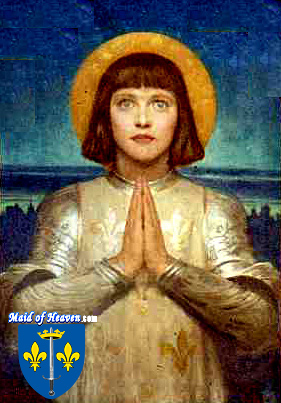

|
Saint Joan of Arc or Jeanne la Pucelle (Joan the Maid) as she preferred to be called lived for only nineteen years but the brilliance of her life continues to inspire and amaze people even today. Joan was the youngest person in history to lead the armies of a nation at only seventeen and her victories at Orleans and Patay are considered among the greatest in all of military history.
Despite her great successes, Joan was captured and put on trial for heresy by her English enemies under the auspices of a Church trial. She was ultimately convicted and declared a relapsed heretic and burned at the stake on May 30, 1430.
Twenty-six years later another trial conducted by the Church (today's Roman Catholic Church) overturned the ruling of the first trial and declared that Joan was a martyr who had been wrongly executed by corrupt partisan clergy who abused a Church trial for secular purposes. In 1920 Joan was officially canonized a Saint by the Roman Catholic Church affirming what so many during her life and down through the ages have believed that she was indeed "A SAINT!"
 EARLY LIFEJoan was born in 1412 on the Feast of the Epiphany which is January 6th. One of Joan's contemporaries, Lord Perceval de Boulanivilliers, described Joan's birth in the following romanticized way: "It was during the night of the Epiphany of Our Lord (January 6, Twelfth Night), when men are wont most joyfully to recall the acts of Christ that she first saw the light in this mortal life. And, wonderful to relate, the poor inhabitants of the place were seized with an inconceivable joy. And though ignorant of the birth of the Maid, they rushed hither and thither in search of what might be the new event. Their hearts as one were conscious of a new gladness" Domremy where Joan was born was a small village in a part of eastern France known as Lorraine. Joan's parents Jacques and Isabelle were peasants later described by a family friend as: "simple laborers, honest in their poverty." Joan was the youngest child having three older brothers, Jacquemin, Jean, and Pierre and a much older sister about whom little is known. Joan spent her days either assisting her mother at home with house chores such as "spinning" or shepherding the animals out in the fields around Domremy. A girl from Joan's village named Haviette who grew up with Joan and was one of her friends later described her in the following way: "Joan was a good, simple and sweet-natured girl, she went often and of her own will to church and the sacred places and often she was ashamed because of people remarking how she went so devoutly to church. I have heard the priest who was there in her time say that she often came to confession. Joan busied herself like any other girl; she did the housework and spun and sometimes, I have seen her, she kept her father's flocks"The time during which Joan grew up was dominated by what is now known as the Hundred Years War and the effects of this war undoubtedly had a profound effect upon Joan. When Joan was young the French were losing the war and the people of France were suffering because their country was being dominated by the invaders from England . Joan's own mother Isabelle later described how this all affected Joan: "Because the people suffered so much, she had a great compassion for them in her heart and despite her youth she would fast and pray for them with great devotion and fervor." 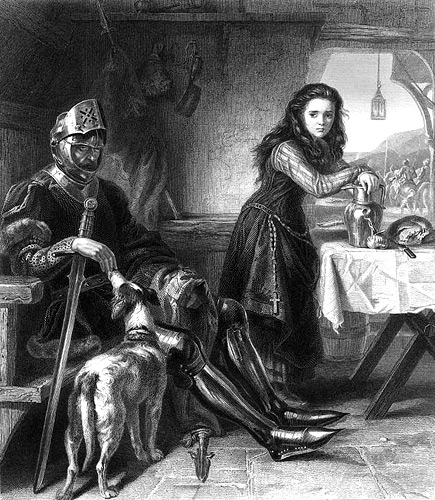 FAITHJoan of Arc's faith and love for God is legendary and was the driving force of her life and must be understood in order to completely understand who Joan was. She was raised as a catholic which was the only Christian church that existed in the age that Joan of Arc lived. Joan was especially nurtured in her faith by her mother Isabelle Romee whose surname Romee is thought to have been honorary for a religious pilgrimage she had once made to Rome. Isabelle later described her daughter's Christian upbringing in the following way: "I had her baptized and confirmed and brought her up in the fear of God. I taught her respect for the traditions of the Church as much as I was able to do given her age and simplicity of her condition. I succeeded so well that she spent much of her time in church and after having gone to confession she received the sacrament of the Eucharist every month."According to numerous statements by the people who lived in Joan's hometown and knew her she was just like everyone else except that she was extremely devout and spent most of her free time in church. "She was good and simple, and went often to the churches and holy shrines. When she was in the fields, she used to drop to her knees and pray every time she heard the church bells toll" is how a farmer from Domremy later described Joan and typifies the statements made by her friends and companions from her hometown. To read more descriptions and learn more visit this page about Joan of Arc's Faith HER VOICES"Voices" is how Joan referred to the heavenly beings that she said visited her and counseled her. When Joan was thirteen she first heard the "Voice from God" that forever changed her life. Joan herself later described this momentous event in her life at her trial: "When I was thirteen years old, I had a Voice from God to help me govern my conduct. And the first time I was very fearful. And came this Voice, about the hour of noon, in the summer-time, in my father's garden; I had not fasted on the eve preceding that day." 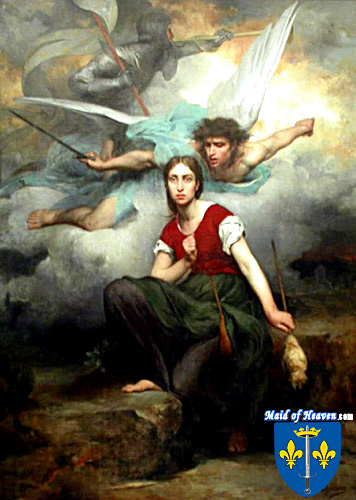 Joan also said at her trial that her Voices were the Archangel Michael, Saint Catherine, and Saint Margaret and further stated that: "I saw them with my bodily eyes, as clearly as I see you; and when they departed I used to weep, and wish that they would take me with them." Joan said that the Voices told her that she must "go into France" (Joan's hometown Domremy was on the edge of what was then considered France proper) and relieve the siege of Orleans and lead Charles the dauphin to his anointing and coronation as King. The reality of Joan's Voices is the most controversial part of Joan of Arc's history and something that can not be proven one way or the other. What is most important for people studying Joan of Arc to understand is that to Joan the Voices were real and she had a firm belief in them that they had been sent to her by God to direct her life. Ultimately the following quote used in regard to other matters of faith is probably most applicable here: "For those who believe in God no explanation is necessary. For those who do not believe in God no explanation is possible." JOAN THE SOLDIERJoan of Arc began her mission as a solider sometime toward the end of 1428 when she left home and traveled to the nearby town of Vaucouleurs to seek assistance from the local military commander Robert de Baudricourt. Joan told de Baudricourt: "I have come to you on the part of my Lord, in order that you may send word to the Dauphin, to hold fast, and to not cease war against his enemies. Before mid-Lent the Lord will give him help. In truth, the kingdom belongs not to the Dauphin, but to my Lord. But my Lord wills that the Dauphin be made King, and have the kingdom in command. Notwithstanding his enemies, the Dauphin will be made King, and it is I who will conduct him to the coronation."Initially de Baudricourt was unconvinced by Joan, who he saw as just a presumptuous peasant girl, telling Joan's uncle Durand Laxart to: "Take her to her father's house, and box her ears." Joan had to make three trips to see him before he finally agreed to give her aid in traveling to Chinon to see Charles VII. No one knows for sure what finally convinced de Baudricourt to assist Joan but legend has it that Joan successfully predicted to de Budricourt the loss by the French at the Battle of Rouvray (Battle of the Herrings) on February 12, 1429. Whatever his reason for changing his mind, de Baudricourt gave Joan a small escort of six that included the two knights Jean de Metz and Bertrand de Poulengy. On the evening of February 23, 1429, Joan and her escort left Vaucouleurs. As she left Joan was asked how she could make such a hazardous journey and she famously replied: "I do not fear the soldiers, for my road is made open to me; and if the soldiers come, I have God, my Lord, who will know how to clear the route that leads to messire the Dauphin. It was for this that I was born!" 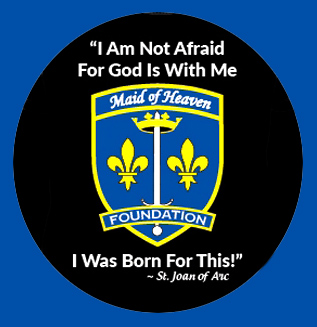
T-Shirt with St Joan's Famous Quote HERE Joan made the perilous winter journey of close to 400 miles in eleven days arriving in Chinon on March 6th. She had to wait for the King's advisors to decide whether Charles would even see her but finally she was given admittance into the Castle of Chinon where Charles was holding court. The first time that Joan met Charles VII has become part of Joan's legend as she was reported to have been able to recognize Charles from a crowd of people where he had withdrawn to conceal himself as a way to test Joan. "When he saw her he asked Joan her name and she replied: 'Gentle Dauphin, I am Joan the Maid, and to you is sent word by me from the King of Heaven that you will be anointed and crowned in Reims and you will be Lieutenant to the King of Heaven who is King of France.' And after other questions put by the King, Joan said to him again. 'I tell the, on behalf of Messire, that thou art true heir of France and the King's son, and He has sent me to thee to lead thee to Reims, that thou may receive thy coronation and anointing, if thou will.' That heard, the King told those who were present that Joan had told him certain secrets that none knew or could know, excepting only God; that is why he had great confidence in her." Father Jean Pasquerel at Joan's Trial of RehabilitationJoan was further tested by Charles VII who had her examined as to her virginity by some of the ladies of his court. Joan was then sent to Poitiers to be examined by a group of ecclesiastics who asked Joan to give them a sign to which she famously responded: "In God's name! I have not come to Poitiers to work signs! But take me to Orleans; and I will show you signs why I am sent." After several weeks of questioning Joan finally obtained the approval of the ecclesiastics who said she should be sent to Orleans with the King's soldiers to show her sign. Around this time, during Holy Week in March of 1429, Joan dictated her first letter to the English warning them to give up their military conquest of France. To prepare Joan to lead the army of France she was next sent to Tours in early April of 1429 where she obtained armor, a sword and had a banner made that depicted God holding the world with the names Jesus and Maria. After Joan was outfitted with all the accoutrements of war she then proceeded to Blois to join the army she would lead. On April 26,1429, Joan lead her army out of Blois to march to Orleans to relieve the city. When they arrived in front of Orleans Joan was not happy that the most direct route had not been taken which she questioned the military leader of Orleans about, lord Dunois who was known as the Bastard of Orleans. "Are you the Bastard of Orleans? Was it you who gave counsel that I come here, on this side of the river, and that I am not to go directly where are Talbot and the English?" Joan then told him: "In Gods's name, the counsel of our Lord is safer and wiser than yours. You have thought to deceive me, and you deceive yourself still more; for I bring you better succor than ever came to any knight or city whatever, seeing that it is the succour of the King of Heaven. Nevertheless, it comes to you not through love of me; it proceeds from God himself, who at the request of Saint Louis and Saint Charlemagne, has had pity for the city of Orleans, and has not wished that the enemy should at the same time possess the person the duke and his city."Despite Joan's initial harsh words, Duonis was thrilled to see her arrive with her army to relieve his town that had been under siege for nearly seven months. As she entered the city of Orleans the people celebrated and she "was received with such great joy by all the inhabitants of both sexes, great and small, that it seemed she was an angel of God." 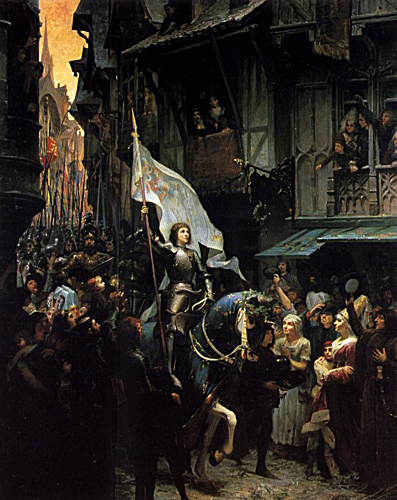 Joan immediately went to work first warning the English with a letter of their peril if they chose maintain their siege of Orleans. Their strongest position was a fort just outside the gates of Orleans in the middle of the Loire River named Les Tourelles which had originally been built by the French to protect the city. Joan favored immediately attacking this stronghold however the military "captains" of her army were against such a bold move. Joan told her captains: "You have been at your council, and I have been at mine. Now, be assured that the counsel of my Lord will fulfill itself and prevail, and that yours will fail." After two days of minor skirmishing around Orleans on May 4th and 6th, during which Joan demonstrated her military and leadership skills, the captains finally agreed to launch a general assault upon Les Tourelles. Joan told her personal chaplain Father Pasquerel to rise early on the morning of April 7, 1429, "for tomorrow I shall have much to do, and greater need of you than I have ever had. Tomorrow the blood will flow from my body, above the breast." Joan had already predicted to Charles VII over a month before that she would be wounded at Orleans so there is no question that she accurately predicted her own wounding that occurred in the initial assault upon Les Tourelles. After Joan was wounded the assault ground to a halt as the daylight dwindled and the French captains tried to figure out how to proceed without Joan. Just as the captains had decided to call off the assault Joan made a miraculous recovery and regaining her banner led her re-inspired men in an assault that completely overwhelmed the defenders in the Tourelles. This amazing turn of events was later described in detail by the leader of Joan's military household, Jean d'Aulon, which can be read in this article titled Joan of Arc's Longest Day. The day after Les Tourelles fell what English that still remained around Orleans deserted their entrenched positions and joined together in an open field in a line of battle. Joan led her forces out to oppose the English however since it was Sunday she ordered that mass be held. After the mass was completed she asked if the English still faced toward the French forces or away. When informed that they faced away she told her men: "In Gods name, they are going. Let them go, while we give thanks to God and pursue them no farther, since today is Sunday." **** This has been a general overview of what was a major battle containing many more details that should be studied to fully understand all that occurred and the importance of this battle. The following page contains more detailed information about the Battle of Orleans. LOIRE VALLEY CAMPAIGNE & PATAY
Joan became known as the Maid of Orleans for her great victory at Orleans, a title by which people of the city still refer to her today. Joan had fulfilled her promise to show "a sign" and had become a hero to the French people however Joan remained focused upon completely the rest of her mission to lead Charles VII to his coronation and anointing in Reims. The way to Reims had to be cleared of enemy soldiers so Joan began what is now known as the Loire Valley Campaigne to clear the way.
JOAN'S CROWNING ACHIEVEMENT
Joan accomplished her greatest achievement in rescuing France when Charles VII was crowned King on July 17, 1429. After annihilating the English forces at Patay, Joan was able to safely conduct Charles to Reims for his coronation and anointing as King. Joan possessed a strategic brilliance and understood how important it was to the ultimate outcome of the war that Charles by crowned as King in the traditional manner so that the French people would accept him as their King and unite behind him. The ceremony took place at the great Cathedral of Reims with Joan standing right beside Charles during the ceremony holding her banner.
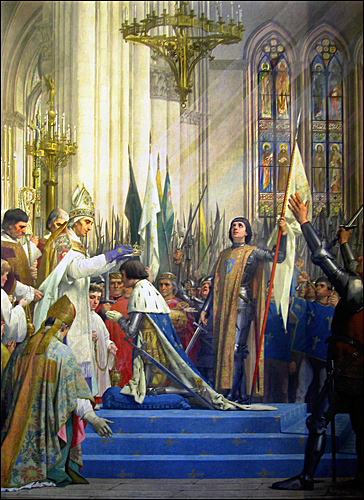 As the ceremony closed, Joan knelt before the newly crowned King and embraced his legs and told him: "Noble King, now is accomplished the pleasure of God, who willed that I should raise the siege of Orleans and should bring you to this city of Reims to receive your holy coronation, thus showing that you are the true King, him to whom the throne of France must belong."For Joan the crowning of Charles VII was the peak of her career however she had changed history forever and the man that she had conducted to the throne would ultimately lead France to complete victory over the English. LAST BATTLES
After the crowning of Charles VII, Joan wanted to immediately march on Paris and liberate France's largest city. This was the logical next step and Paris was still lightly defended with the English and Burgundians still reeling from Joan's spectacular victories in the previous months. But Charles VII had different plans now that he was officially the King, and unduly influenced by his unscrupulous advisors Georges de La Tremouille and Regnault de Chartres, he entered into several worthless treaties with Burgundy that delayed Joan from launching her attack on Paris. When the attack was finally begun on September 8, 1429, Paris had been reinforced by English and Burgundian troops which made the effort much more difficult than it would have been only a month and a half before.
CAPTURE & IMPRISONMENT
After Joan had triumphed at Orleans she had told Charles VII to use her well for "I shall last but a year, little more." As May of 1430 was drawing to an end the year that Joan had predicted she would last was also coming to a close and the town of Compiegne was under siege and begging for help. When Joan heard about the plight of Compiegne she announced: "By my staff! We are enough! I shall go to my good friends at Compiegne!"
"The captain of the place, seeing the great multitude of Burgundians and English about to enter upon the bridge, for the fear he had lest he lose the town, had the bridge into the town raised and the gates closed, and thus the Maid remained closed outside with a few of her men with her. When the enemy saw this all tried hard to capture her. She resisted very strongly against them, and in the end had to be taken by five or six together, the one putting his had on her, the others on her horse, each of them saying, 'surrender yourself to me and give me your promise.' She responded: 'I have already sworn and given my faith to another than you, and to Him only will I keep my oath.'"Joan became a prisoner-of-war (POW) of the Burgundian John of Luxemburg who had her taken to his castle at Beaulieu and then on to his more secure castle at Beaurevoir. Joan spent almost six months as a prisoner of John of Luxemburg during which time she could easily have been ransomed back to Charles VII as was the custom for military prisoners. She could also have been rescued by military action if Charles VII had really desired to gain her freedom however there is no credible evidence that Charles ever made any attempt to aid Joan. John of Luxemburg was little concerned with receiving a ransom payment from Charles VII because he was negotiating with the English through Bishop Pierre Cauchon to sell her to them so that they could put her on trial for heresy. When Joan found out she had been sold she apparently became desperate to escape and attempted a leap from a tower where she was held that was sixty feet tall. It was a miracle that Joan survived the fall however she was knocked unconscious and recaptured. Joan later explained about her desperate leap: "I was sold to the English and I preferred to die rather than be in the hands of the English." In mid-November of 1430 Joan of Arc was transferred into the hands of the English for ten thousand francs and began her journey to her final destination of Rouen. TRIAL & DEATH
The trial of Joan of Arc was conducted by officials of the Church (today's Roman Catholic Church) however they were hand picked by the English who paid for the proceedings and were in complete control. The reason the English, ruled by the Duke of Bedford through his young nephew Henry VI, went to all the trouble of putting Joan on trial was because they believed if they could discredit her with the taint of being a heretic it would also discredit the King she had crowned, Charles VII, and again reverse the course of the war back in their favor.
"Some, for example, the Bishop of Beauvais, obeyed their partiality for the English cause. Others, such as two or three English doctors, were impelled by a desire for vengeance. Others, like the doctors of Paris, were attracted by the prospect of compensation. Others, among them the Vice-inquisitor, yielded to fear."Cauchon's court did everything possible to get Joan to stumble and provide damming evidence against herself but she proved to be very capable of defending herself. One of her most famous replies in her trial came when she was asked whether or not she thought she was in a state of grace. This was supposed to be a trick question as an affirmation would presume to know the "mind" of God while a denial would mean she felt herself already damned. Joan famously responded: "If I am not, may God put me there; and if I am, may God so keep me. I should be the saddest creature in the world if I knew I were not in His grace"Once Cauchon realized that Joan would not be as easy to convict of heresy as he had originally thought he began altering the procedure of the trial. On March 10th the examinations resumed in private in Joan's prison cell with a select group of judges. Cauchon also sent spies into the prison with Joan to gain her confidence and collect evidence that could be used against her. Cauchon even went so far as to threaten Joan with torture on May 9th however the threat did not work as Joan angrily screamed at them: "Truly, if you were to tear me limb from limb and separate my soul from my body, I would not say anything more. If I did say anything, afterwards I would always declare that you made me say it by force!"Finally Cauchon had Joan taken to the cemetery at St. Ouen on May 24th where she was threatened with burning if she did not "abjure" which meant to admit guilt to all she was accused of and submit to Cauchon's court. After the long months of the trial Joan was undoubtedly weary and combined with her great fear of being burned she agreed to abjure and signed a paper put in front of her. She had been promised that if she agreed to abjure her trial would be over and she would be taken to a Church prison to be guarded by women. Cauchon immediately reversed this promise and had Joan taken back to her prison cell where she was again guarded by coarse English soldiers. As part of Joan's abjuration she had agreed to wear a dress instead of her soldiers clothes which Cauchon's court had made a big issue about lacking any real evidence that Joan was a heretic. Joan had always contended that wearing men's clothing was her only way to protect her chastity when she was around soldiers such as the men who guarded her in prison. Cauchon apparently now used Joan's predicament over her clothes to force her into going back on her abjuration so that he could declare her a relapsed heretic and have her burned at the stake. No one really knows all that happened to Joan after she was returned to her prison cell on May 24th, and whether she was actually raped, but three days later when several of the judges went to see her they found that she had resumed male attire. Cauchon had told the Earl of Warwick not to worry after being chastised by him for allowing Joan to escape the fire on the 24th because he said: "we shall easily catch her again." After Joan was found in male clothing Cauchon told the English: "Be of good cheer, the deed it done." On May 29th the judges who were still willing to participate in the scurrilous proceedings met and voted that Joan was a relapsed heretic who should be punished with death by fire. On May 30, 1431, Joan of Arc was taken to the old square of Rouen where she was executed by being burned to death. Father Jean Massieu, court bailiff in Joan's trial, described the scene of her death: "...she was led to the Vieux Marche, and beside her walked Friar Martin and myself, with an escort of eight hundred soldiers armed with axes and swords. And when she came to the Vieux Marche she listened to the sermon with great fortitude and most calmly, showing signs and evidence and clear proof of her contrition, penitence and fervent faith she uttered pious and devout lamentations and called on the Blessed Trinity, and upon the blessed and glorious Virgin Mary, and on all the blessed saints in Paradise, naming many in her devotions, her lamentation, and her true confession of faith. She also most humbly begged all manner of people, of whatever condition or rank they might be, and whether of her party or not, for their pardon and asked them kindly to pray for her, at the same time pardoning them for any harm they had done her. This she continued to do for a very long time, perhaps for half an hour and until the end. The judges who were present, and even several of the English, were moved by this to great tears and weeping, and indeed several of these same English, recognized God's hand and made professions of faith when they saw her make so remarkable an end. They were glad to have witnessed her end and said that she had been a good woman. When she was handed over by the Church, I remained with her, and she asked most fervently to be given a cross. An Englishman who was present heard this and made her a little one out of wood from the end of a stick and handed it to her. She received it and kissed it most devotedly, uttering pious lamentations and acknowledging God our Savior, who suffered for our redemption on the Cross, of which she had there the symbol and representation. Then she put that cross on her breast between her body and her clothes and humbly asked me to let her have the crucifix from the church so that she could gaze on it continuously until her death. I saw to it that the clerk of the parish church of Saint Sauveur brought it to her. When it was brought, she embraced it closely and for a long time and clung to it until she was tied to the stake. While she was praying her prayers and piously lamenting, I was urgently pressed by the English, and by one of their captains in particular, to hand her over to them, as they were in a hurry for her death. While I was doing my best to comfort her on the scaffold, this man said to me, 'What priest, are you going to keep us here till suppertime?' Then without any formality or any reading of the sentence, they dispatched her straight to the fire, saying to the executioner, 'Do your duty.' And so while she was still uttering devoted praise and lamentations to God and the saints, she was led and tied to the stake. And her last word, as she died, was a loud cry of 'Jesus'." 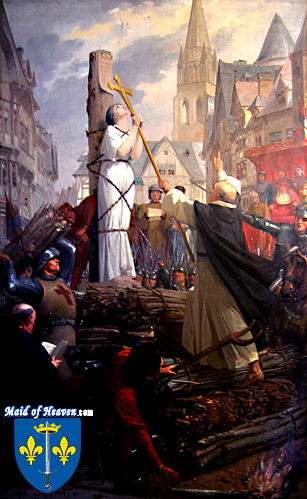 **** The preceding has been a cursory overview on the Trial of Joan of Arc. The trial lasted for almost five months and contains a great amount of detail that should be studied in order to really understand all that transpired. To learn more please utilize the resources listed at Joan of Arc's Trial JOAN THE SAINTWhile Joan of Arc was alive many people already believed that she was a saint. Lord Dunois her comrade in arms and the commander at Orleans stated: "I believe that Joan was sent by God and that her deeds in the war were the fruit of divine inspiration rather than of human agency." Jean de Metz, Joan's faithful knight, echoed Dunois' sentiments and his description of her below probably represented how most of the people who knew Joan felt: "In truth I believe that Joan could only have been sent from God. She never swore, she loved to attend holy service, she made devoutly the sign of the cross, she confessed often and was zealous in giving alms. It happened to me several times to provide her with money, which she gave for the love of God."Even many of Joan's enemies and the people responsible for her death said much the same thing. After she was executed several of the men who had participated exhibited great remorse for their part in her death. An English soldier who had hated her and had sworn to personally add a stick to her fire was struck with fright when he heard Joan cry "Jesus" and die at the very instant he added to the fire. Later at a tavern where his comrades had taken him to try to console him the soldier kept repeating "she was a saint" and swore he had seen a white dove fly away toward France the very moment she had died. Joan's own executioner despaired to the point that he sought the aid of priests who said that he stated: "I fear that I shall be damned for I have burned a holy woman." The secretary of the King of England, Master Jean Tressard, lamented after witnessing Joan's execution: "We are all lost for it is a good and holy woman that has been burned. I believe her soul is in the hands of God, and I believe damned all who participated in her condemnation." If only the English and the people who had fought against Joan had listened to the words of Joan's fellow countryman the poet Christine de Pisan who had written to them in a poem in the summer of 1429: can you not see in this God's hand? For only the truly stupid can not see this was done at His command. How else could the Maid have struck you down except she was sent to us by Him? You don't have the strength, give in! Do you really want to fight against Him? In 1450, after the English had finally been expelled from France as Joan had predicted, a new trial was begun by the Church to investigate the first trial that had condemned her in 1431. After more than six years of investigation and examinations of everyone still alive who had known Joan, the new trial, now known as Joan's Trial of Nullification or Rehabilitation, overturned her conviction and declared that Joan was a martyr, which in those days was tantamount to saying that she was a saint. The official declaration of sainthood by the Church did not actually take place until 1920. During the process of canonization at Joan's Beatification Pope Pius X said of Joan that she "is a witness to divine power, which 'has chosen what is weak in the world to confound what is strong'" (1 Cor 1:27) and further stated: "And so, the renowned maiden achieved immortal glory, but the tale of her sanctity and the memory of her deeds has lived on in the mouths of men, especially in the city of Orleans, even up to the secular honors that have recently been given to her, and it will live on for future generations always fresh with new praise. Indeed, the praise first given to Judith seems to fall appropriately to her also, 'In every nation that hears your name, the God of Israel will be magnified on your account'" (Judith 13:31).When Pope Benedict XV officially canonized Joan a saint on May 16, 1920, he expressed in his final words what so many people had already concluded about Joan that she is a "most brilliantly shining light" of God and a true Saint. In closing this biography about Saint Joan of Arc can it be any more appropriate than to end with the scripture that probably best sums up her incredible life and legacy: "With God All Things Are Possible"
 This biography was written by Joan of Arc Biographer and Historian Ben D. Kennedy © 2010. All rights reserved. |